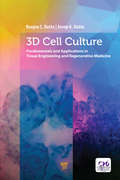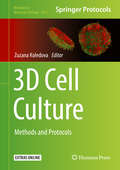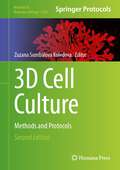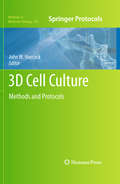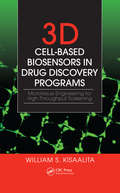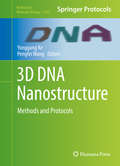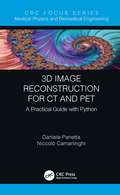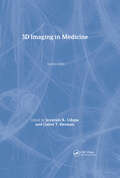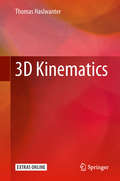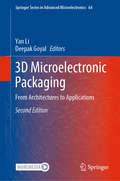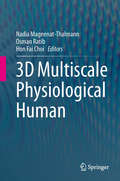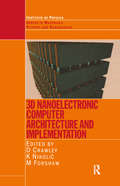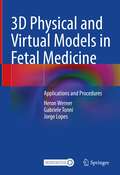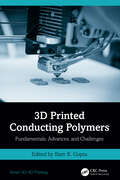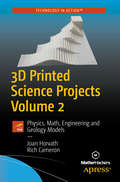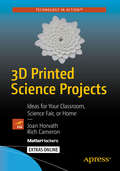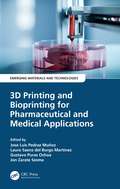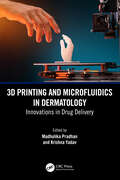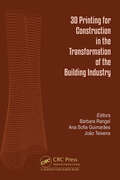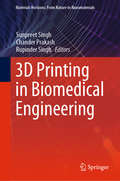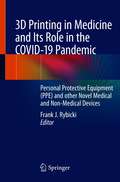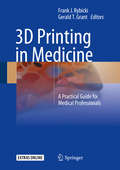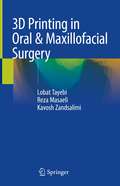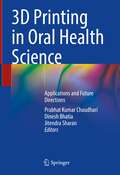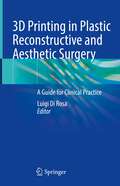- Table View
- List View
3D Cell Culture: Fundamentals and Applications in Tissue Engineering and Regenerative Medicine
by Ranjna C. Dutta Aroop K. Dutta3D cell culture is yet to be adopted and exploited to its full potential. It promises to upgrade and bring our understanding about human physiology to the highest level with the scope of applying the knowledge for better diagnosis as well as therapeutics. The focus of this book is on the direct impact of novel technologies and their evolution into viable products for the benefit of human race. It also describes the fundamentals of cell microenvironment to bring forth the relevance of 3D cell culture in tissue engineering and regenerative medicine. It discusses the extracellular matrix/microenvironment (ECM) and emphasizes its significance for growing cells in 3D to accomplish physiologically viable cell mass/tissue ex vivo. The book bridges the knowledge gaps between medical need and the technological applications through illustrations. It discusses the available models for 3D cell culture as well as the techniques to create substrates and scaffolds for achieving desired 3D microenvironment.
3D Cell Culture: Methods and Protocols (Methods in Molecular Biology #1612)
by Zuzana KoledovaThis book provides an overview of established 3D cell culture assays from leaders in the field. Their contributions cover a wide spectrum of techniques and approaches for 3D cell culture, from organoid cultures through organotypic models to microfluidic approaches and emerging 3D bioprinting techniques, which are used in developmental, stem cell, cancer, and pharmacological studies, among many others. Written for the highly successful Methods in Molecular Biology series, chapters include introductions to their respective topics, lists of the necessary materials and reagents, step-by-step, readily reproducible laboratory protocols, and tips on troubleshooting and avoiding known pitfalls. Comprehensive and cutting-edge, 3D Cell Culture: Methods and Protocols aims to inspire researchers to develop novel 3D cell culture techniques according to their specific scientific needs and interests, leading to a new generation of physiologically relevant and realistic 3D cell cultures. Chapter 15 of this book is available open access under a CC BY 4. 0 license.
3D Cell Culture: Methods and Protocols (Methods in Molecular Biology #2764)
by Zuzana Sumbalova KoledovaSince the publication of the previous edition, the use of 3D cell and organoid cultures has become more widespread across laboratories. This second edition volume expands on the previous edition with discussions about the latest organoid models developed for many more organs; new hydrogels and devices for 3D culture; and the organoid systems that have been improved by incorporating more components of tissue microenvironments in the in vitro culture. The chapters in this book are organized into five parts and cover topics such as biofabrication, organoids, microfluidic systems, bioprinting, and image analysis. Written in the highly successful Methods in Molecular Biology series format, chapters include introductions to their respective topics, lists of the necessary materials and reagents, step-by-step, readily reproducible laboratory protocols, and tips on troubleshooting and avoiding known pitfalls.Thorough and cutting-edge, 3D Cell Culture: Methods and Protocols, Second Edition is a valuable resource that will stimulate new ideas, foster interdisciplinary collaborations, and contribute to the improvement of human health and well-being.
3D Cell Culture: Methods and Protocols (Methods in Molecular Biology #695)
by John W. HaycockDeveloped for a range of tissues where the culture environment takes into account the spatial organization of the cells therein, 3D cell culture models serve to bridge the gap between in vivo studies at one extreme with that of simple cell monolayers at the other. In 3D Cell Culture: Methods and Protocols, international experts describe a number of basic and applied methodologies taken from a breadth of scientific and engineering disciplines, many of which deal with direct applications of 3D culture models, most notably in the formation of tissues for clinical purpose. Beginning with an overview of the biological and materials scaffold requirements for successfully creating 3D models, the book delves into topics such as general scaffold design and fabrication techniques, models for bone, skin, cartilage, nerve, bladder, and hair follicles, and chapters on bioreactor design, imaging, and stem cells. Written in the highly successful Methods in Molecular BiologyTM series format, chapters include brief introductions to their respective subjects, lists of the necessary materials, step-by-step, readily reproducible laboratory protocols, and notes on troubleshooting and avoiding known pitfalls. Authoritative and cutting-edge, 3D Cell Culture: Methods and Protocols serves as a basic manual for laboratory-based scientists who not only need to have a comprehensive range of techniques contained within a single text but also require techniques described using a standard, convenient format.
3D Cell-Based Biosensors in Drug Discovery Programs: Microtissue Engineering for High Throughput Screening
by William S. KisaalitaAdvances in genomics and combinatorial chemistry during the past two decades inspired innovative technologies and changes in the discovery and pre-clinical development paradigm with the goal of accelerating the process of bringing therapeutic drugs to market. Written by William Kisaalita, one of the foremost experts in this field, 3D Cell-Based Bio
3D DNA Nanostructure: Methods and Protocols (Methods in Molecular Biology #1500)
by Yonggang Ke Pengfei WangThis detailed volume presents a comprehensive technical overview of DNA nanotechnology with an emphasis on 3D DNA nanostructure design and applications. Coverage spans from basic design principles for DNA and RNA nanostructures to their cutting-edge applications in a variety of fields, with the book divided into basic DNA and RNA nanostructure design strategies as well as applications utilizing DNA nanostructures, including but not limited to nanomedicine, bioimaging, biosensing, nanoplasmonics, nanoelectronics, nanofabrication, crystallography, biophysics, and analytical chemistry. Written for the highly successful Methods in Molecular Biology series, chapters include introductions to their respective topics, lists of the necessary materials and reagents, step-by-step, readily reproducible laboratory protocols, and tips on troubleshooting and avoiding known pitfalls. Comprehensive and authoritative, 3D DNA Nanostructure: Methods and Protocols provides the most up-to-date tutorial style overviews and technical style protocols to benefit researchers in a wide variety of areas.
3D Image Reconstruction for CT and PET: A Practical Guide with Python (Focus Series in Medical Physics and Biomedical Engineering)
by Daniele Panetta Niccolo CamarlinghiThis is a practical guide to tomographic image reconstruction with projection data, with strong focus on Computed Tomography (CT) and Positron Emission Tomography (PET). Classic methods such as FBP, ART, SIRT, MLEM and OSEM are presented with modern and compact notation, with the main goal of guiding the reader from the comprehension of the mathematical background through a fast-route to real practice and computer implementation of the algorithms. Accompanied by example data sets, real ready-to-run Python toolsets and scripts and an overview the latest research in the field, this guide will be invaluable for graduate students and early-career researchers and scientists in medical physics and biomedical engineering who are beginners in the field of image reconstruction. A top-down guide from theory to practical implementation of PET and CT reconstruction methods, without sacrificing the rigor of mathematical background Accompanied by Python source code snippets, suggested exercises, and supplementary ready-to-run examples for readers to download from the CRC Press website Ideal for those willing to move their first steps on the real practice of image reconstruction, with modern scientific programming language and toolsets Daniele Panetta is a researcher at the Institute of Clinical Physiology of the Italian National Research Council (CNR-IFC) in Pisa. He earned his MSc degree in Physics in 2004 and specialisation diploma in Health Physics in 2008, both at the University of Pisa. From 2005 to 2007, he worked at the Department of Physics "E. Fermi" of the University of Pisa in the field of tomographic image reconstruction for small animal imaging micro-CT instrumentation. His current research at CNR-IFC has as its goal the identification of novel PET/CT imaging biomarkers for cardiovascular and metabolic diseases. In the field micro-CT imaging, his interests cover applications of three-dimensional morphometry of biosamples and scaffolds for regenerative medicine. He acts as reviewer for scientific journals in the field of Medical Imaging: Physics in Medicine and Biology, Medical Physics, Physica Medica, and others. Since 2012, he is adjunct professor in Medical Physics at the University of Pisa. Niccolò Camarlinghi is a researcher at the University of Pisa. He obtained his MSc in Physics in 2007 and his PhD in Applied Physics in 2012. He has been working in the field of Medical Physics since 2008 and his main research fields are medical image analysis and image reconstruction. He is involved in the development of clinical, pre-clinical PET and hadron therapy monitoring scanners. At the time of writing this book he was a lecturer at University of Pisa, teaching courses of life-sciences and medical physics laboratory. He regularly acts as a referee for the following journals: Medical Physics, Physics in Medicine and Biology, Transactions on Medical Imaging, Computers in Biology and Medicine, Physica Medica, EURASIP Journal on Image and Video Processing, Journal of Biomedical and Health Informatics.
3D Imaging in Medicine, Second Edition
by Gabor T. Herman Jayaram K. UdupaThis book provides a quick and systematic presentation of the principles of biomedical visualization and three-dimensional (3D) imaging. Topics discussed include basic principles and algorithms, surgical planning, neurosurgery, orthopedics, prosthesis design, brain imaging, cardio-pulmonary structure analysis and the assessment of clinical efficacy. Students, scientists, researchers, and radiologists will find 3D Imaging in Medicine a valuable source of information for a variety of actual and potential clinical applications for 3-D imaging.
3D Kinematics
by Thomas HaslwanterThis book presents an introduction to the analysis of general movements in 3D space, especially for movements of the human body. It is based on the lecture notes of a class on 3D Kinematics, which the author has been holding in the Master Degree Program of his home institution, the University of Applied Sciences Upper Austria. The lecture introduces the mathematics underlying the measurement and analysis of 3D movements. The target audience primarily comprises research experts in the field, but the book may also be beneficial for graduate students alike.
3D Microelectronic Packaging: From Architectures to Applications (Springer Series in Advanced Microelectronics #64)
by Yan Li Deepak GoyalThis book offers a comprehensive reference guide for graduate students and professionals in both academia and industry, covering the fundamentals, architecture, processing details, and applications of 3D microelectronic packaging. It provides readers an in-depth understanding of the latest research and development findings regarding this key industry trend, including TSV, die processing, micro-bumps for LMI and MMI, direct bonding and advanced materials, as well as quality, reliability, fault isolation, and failure analysis for 3D microelectronic packages. Images, tables, and didactic schematics are used to illustrate and elaborate on the concepts discussed. Readers will gain a general grasp of 3D packaging, quality and reliability concerns, and common causes of failure, and will be introduced to developing areas and remaining gaps in 3D packaging that can help inspire future research and development.
3D Multiscale Physiological Human
by Nadia Magnenat-Thalmann Osman Ratib Hon Fai Choi3D Multiscale Physiological Human aims to promote scientific exchange by bringing together overviews and examples of recent scientific and technological advancements across a wide range of research disciplines. As a result, the variety in methodologies and knowledge paradigms are contrasted, revealing potential gaps and opportunities for integration. Chapters have been contributed by selected authors in the relevant domains of tissue engineering, medical image acquisition and processing, visualization, modeling, computer aided diagnosis and knowledge management. The multi-scale and multi-disciplinary research aspects of articulations in humans are highlighted, with a particular emphasis on medical diagnosis and treatment of musculoskeletal diseases and related disorders. The need for multi-scale modalities and multi-disciplinary research is an emerging paradigm in the search for a better biological and medical understanding of the human musculoskeletal system. This is particularly motivated by the increasing socio-economic burden of disability and musculoskeletal diseases, especially in the increasing population of elderly people. Human movement is generated through a complex web of interactions between embedded physiological systems on different spatiotemporal scales, ranging from the molecular to the organ level. Much research is dedicated to the understanding of each of these systems, using methods and modalities tailored for each scale. Nevertheless, combining knowledge from different perspectives opens new venues of scientific thinking and stimulates innovation. Integration of this mosaic of multifaceted data across multiple scales and modalities requires further exploration of methods in simulations and visualization to obtain a comprehensive synthesis. However, this integrative approach cannot be achieved without a broad appreciation for the multiple research disciplines involved.
3D Nanoelectronic Computer Architecture and Implementation (Series in Material Science and Engineering)
by David Crawley K. Nikolic M. ForshawIt is becoming increasingly clear that the two-dimensional layout of devices on computer chips hinders the development of high-performance computer systems. Three-dimensional structures will be needed to provide the performance required to implement computationally intensive tasks. 3-D Nanoelectronic Computer Architecture and Implementation reviews the state of the art in nanoelectronic device design and fabrication and discusses the architectural aspects of 3-D designs, including the possible use of molecular wiring and carbon nanotube interconnections. This is a valuable reference for those involved in the design and development of nanoelectronic devices and technology.
3D Physical and Virtual Models in Fetal Medicine: Applications and Procedures
by Gabriele Tonni Heron Werner Jorge LopesTechnological innovations accompanying advances in medicine have given rise to the possibility of obtaining better-defined fetal images that assist in medical diagnosis and contribute toward genetic counseling offered to parents during the prenatal care. 3D printing is an emerging technique with a variety of medical applications such as surgical planning, biomedical research and medical education.Clinical Relevance: 3D physical and virtual models from ultrasound and magnetic resonance imaging have been used for educational, multidisciplinary discussion and plan therapeutic approaches. The authors describe techniques that can be applied at different stages of pregnancy and constitute an innovative contribution to research on fetal abnormalities. We will show that physical models in fetal medicine can help in the tactile and interactive study of complex abnormalities in multiple disciplines. They may also be useful for prospective parents because a 3D physical model with the characteristics of the fetus should allow a more direct emotional connection to their unborn child.
3D Printed Conducting Polymers: Fundamentals, Advances, and Challenges (Smart 3D/4D Printing)
by Ram K. GuptaConducting polymers are smart materials that possess unique and tuneable electrical, optical, and electrochemical properties. 3D printing technology is rapidly advancing, and using conducting polymers for this process can lead to many emerging applications as it can print complex structures cost effectively, though many challenges need to be overcome before this technology can be used on a large scale. 3D Printed Conducting Polymers highlights the state of the art of these materials, the basics of additive printing, and the role of conducting polymers in additive manufacturing. It also discusses applications in energy, sensors, and biomedical areas. Covers fundamentals, synthesis, and various applications of conducting polymers. Discusses basics of energy devices, sensors, and materials technology for emerging applications. Explores new approaches for the synthesis of conducting polymers and composites for 3D print technology. Details future applications and challenges. Offering direction to researchers and advanced students to better understand the chemistry and electrochemical properties of conducting polymers and technologies for 3D printing, this book advances the science and technology of this emerging field for readers in materials and chemical engineering, biotechnology, energy, and related disciplines.
3D Printed Science Projects Volume 2: Physics, Math, Engineering and Geology Models
by Joan Horvath Rich CameronLearn physics, engineering, and geology concepts usually seen in high school and college in an easy, accessible style. This second volume addresses these topics for advanced science fair participants or those who just like reading about and understanding science. 3D Printed Science Project Volume 2 describes eight open-source 3D printable models, as well as creative activities using the resulting 3D printed pieces. The files are designed to print as easily as possible, and the authors give tips for printing them on open source printers. As 3D printers become more and more common and affordable, hobbyists, teachers, parents, and students stall out once they've printed some toys and a few household items. To get beyond this, most people benefit from a "starter set" of objects as a beginning point in their explorations, partially just to see what is possible. This book tells you the solid science stories that these models offer, and provides them in open-source repositories. What You Will Learn: Create (and present the science behind) 3D printed models Review innovative ideas for tactile ways to learn concepts in engineering, geology and physics Learn what makes a models easy or hard to 3D print Who This Book Is For: The technology- squeamish teacher and parents who want their kids to learn something from their 3D printer but don't know how, as well as high schoolers and undergraduates.
3D Printed Science Projects: Ideas for your classroom, science fair or home
by Joan Horvath Rich Cameron3D Printed Science Projects describes how to create 3D printable models that can help students from kindergarten through grad school learn math, physics, botany, chemistry, engineering and more. Each of the eight topics is designed to be customized by the reader to create a wide range of projects suitable for science fairs, extra credit, or classroom demonstrations. Science fair project suggestions and extensive "where to learn more" resources are included, too. You will add another dimension to your textbook understanding of science. What you'll learn To create (and present the science behind) 3D printed models. To use a 3D printer to create those models as simply as possible. New science insights from designing 3D models. Who this book is for This book shows parents and teachers how to use the models inside as starting points for 3D printable explorations. Students can start with these models and vary them for their own explorations. Unlike other sets of models that can just be scaled, these models have the science built-in to allow for more insight into the fundamental concepts. Topics covered in this book: 3D Math Functions Light and Other Waves Gravity Airfoils Simple Machines Plants and their Ecosystems Molecules Trusses
3D Printing and Bioprinting for Pharmaceutical and Medical Applications (Emerging Materials and Technologies)
by Jose Luis Pedraz Muñoz Laura Saenz del Burgo Martínez Gustavo Puras Ochoa Jon Zarate SesmaThe increasing availability and decreasing costs of 3D printing and bioprinting technologies are expanding opportunities to meet medical needs. 3D Printing and Bioprinting for Pharmaceutical and Medical Applications discusses emerging approaches related to these game-changer technologies in such areas as drug development, medical devices, and bioreactors. Key Features: Offers an overview of applications, the market, and regulatory analysis Analyzes market research of 3D printing and bioprinting technologies Reviews 3D printing of novel pharmaceutical dosage forms for personalized therapies and for medical devices, as well as the benefits of 3D printing for training purposes Covers 3D bioprinting technology, including the design of polymers and decellularized matrices for bio-inks development, elaboration of 3D models for drug evaluation, and 3D bioprinting for musculoskeletal, cardiovascular, central nervous system, ocular, and skin applications Provides risk-benefit analysis of each application Highlights bioreactors, regulatory aspects, frontiers, and challenges This book serves as an ideal reference for students, researchers, and professionals in materials science, bioengineering, the medical industry, and healthcare.
3D Printing and Microfluidics in Dermatology: Innovations in Drug Delivery
by Madhulika Pradhan Krishna Yadav3D Printing and Microfluidics in Dermatology provides a thorough exploration and applications of three-dimensional (3D) printing and microfluidics within the field of dermatology. It investigates various methods utilized in these fields, such as 3D bioprinting, nano-transporters, microscopic fabrication, and device development.The book not only examines practical applications but also delves into the design principles crucial for implementing these techniques using specific materials tailored to their intended purposes. Additionally, it addresses ethical concerns and regulatory considerations pertinent to these evolving technologies.Key highlights include the following: A detailed insight into the utilization of 3D printing and microfluidic technologies for treating skin disorders. Exploration of design concepts necessary for effective implementation, considering the unique properties of materials involved. Coverage of diverse methodologies, ranging from 3D bioprinting to nano-transporters, microscopic fabrication, and device engineering. In-depth discussion on ethical considerations vital for the sustainable development of the industry. Investigation into advancements in material development, device design, fabrication techniques, and performance evaluation through preclinical and clinical studies. This book targets graduate students and researchers in fields such as 3D printing, dermatology, drug delivery, bioengineering, and pharmaceutical sciences.
3D Printing for Construction in the Transformation of the Building Industry
by Ana Sofia Guimarães Bárbara Rangel João TeixeiraAs concrete revolutionised construction in the 20th century, digitalisation is transforming the building industry (BI). Process automation and 3D printing (3DP) are commonplace in the industry and our homes. However, due to BI’s scale and complexity, Additive Manufacturing (AM) is in its native stage. Ongoing scientific research has been providing knowledge that will simplify the integration of 3DCP in the market, exploring its materiality, technologies, and design methodologies. This book provides an overview of the latest research achievements of the design possibilities that 3DP for construction (3DC) can offer in the various fields of construction, particularly architecture and engineering.
3D Printing in Biomedical Engineering (Materials Horizons: From Nature to Nanomaterials)
by Rupinder Singh Chander Prakash Sunpreet SinghThis book gives a comprehensive overview of the rapidly evolving field of three-dimensional (3D) printing, and its increasing applications in the biomedical domain. 3D printing has distinct advantages like improved quality, cost-effectiveness, and higher efficiency compared to traditional manufacturing processes. Besides these advantages, current challenges and opportunities regarding choice of material, design, and efficiency are addressed in the book. Individual chapters also focus on select areas of applications such as surgical guides, tissue regeneration, artificial scaffolds and implants, and drug delivery and release. This book will be a valuable source of information for researchers and professionals interested in the expanding biomedical applications of 3D printing.
3D Printing in Medicine and Its Role in the COVID-19 Pandemic: Personal Protective Equipment (PPE) and other Novel Medical and Non-Medical Devices
by Frank J. RybickiThis book describes how “makers” with no medical experience became and remain clinically important because they utilized 3D printing to produce supplies for healthcare, including medical and non-medical devices, and to improve the quality of life for patients with COVID-19 and those who care for them. It shows how 3D printing became vital during the pandemic due to its broad availability and the inherently digital nature of the work that enables thriving digital exchanges and work in isolation. Subsequent chapters highlight some of the “maker” communities' efforts that made a difference in their part of North America. Each contribution describes the unique experiences, challenges, and successes.While this book is written and edited mostly from a medical perspective, additional input from medical engineers, administrators, attorneys, and public safety officials enables a broad perspective to highlight some of the ingenuity from the North American 3D printing community who responded to the initial case volumes of COVID-19.
3D Printing in Medicine: A Practical Guide for Medical Professionals
by Frank J. Rybicki Gerald T. GrantThis book describes the fundamentals of three-dimensional (3D) printing, addresses the practical aspects of establishing a 3D printing service in a medical facility, and explains the enormous potential value of rendering images as 3D printed models capable of providing tactile feedback and tangible information on both anatomic and pathologic states. Individual chapters also focus on selected areas of applications for 3D printing, including musculoskeletal, craniomaxillofacial, cardiovascular, and neurosurgery applications. Challenges and opportunities related to training, materials and equipment, and guidelines are addressed, and the overall costs of a 3D printing lab and the balancing of these costs against clinical benefits are discussed. Radiologists, surgeons, and other physicians will find this book to be a rich source of information on the practicalities and expanding medical applications of 3D printing.
3D Printing in Oral & Maxillofacial Surgery
by Lobat Tayebi Reza Masaeli Kavosh ZandsalimiThis book is a comprehensive guide to 3D printing and 3D bioprinting methods and their application in oral and maxillofacial surgeries. Among the 3D printing methods considered are fused deposition modeling, selective laser sintering, photopolymer jetting, powder binder printing, and stereolithography, while the coverage of 3D bioprinting encompasses inkjet, microextrusion, and laser techniques. In each case, the relevance of the technique to oral and maxillofacial surgery is explained. In addition, the available inks and bioinks for 3D printing are reviewed. The roles of soft and hard tissue printing in oral and maxillofacial tissue engineering and the use of 3D printing in multi- and interfacial tissue engineering are then examined in depth. The particular value of 3D printing in the treatment of critically sized defects is discussed separately. Finally, up-to-date information is provided on guided tissue/bone regeneration using 3D printing. The book will be of interest to both oral and maxillofacial surgeons and biomedical engineers.
3D Printing in Oral Health Science: Applications and Future Directions
by Prabhat Kumar Chaudhari Dinesh Bhatia Jitendra SharanThis book on 3D printing in oral health science aims to equip the reader with a sound understanding of contemporary clinical applications in all fields of dentistry and their future directions. In the last few years, the development of 3D printing for medical and dental applications has increased tremendously. Advancements in 3D printing create the possibility of customized products, savings on small-scale productions, ease of sharing and processing of patient image data, and educational up-gradation. Looking at the dental specialties, it is evident that 3D printing has applications in all aspects of oral health science including prosthodontics, oral surgery, periodontics, endodontics, and orthodontics. This book will cover all major fields in dentistry and will help the practitioner in the process of decision-making and apply concepts in clinical or laboratory practice. It is based on current scientific evidence to provide readers with an up-to-date contemporary understanding of the subject, both from the clinical and the technological side. The book is a valuable asset for all who specialize in 3D printing and for those interested in learning more about this field.
3D Printing in Plastic Reconstructive and Aesthetic Surgery: A Guide for Clinical Practice
by Luigi Di RosaThis handy volume illustrates the basics of clinical three-dimensional (3D) printing, addressing the practical aspects of establishing a simple and effective 3D printing service in a medical facility. No longer confined to makers and workshops, this very recent technology has been fast developing and rapid prototyping has proven its potential in the clinical field as well, leading to new approaches. The declared aim of this work is enabling medical professionals to create bespoke anatomical models from a series of CT or MRI images, and assisting them in choosing the best suited 3D printers and materials for each specific clinical need. The text includes original, full-color step-by-step photos for better guidance, and a complete review of related publications in literature. Single chapters devoted to specific areas of 3D printing application, such as rhinoplasty, ear reconstruction, oculoplasty, maxillofacial surgery, as well as for surgical simulations. Contents are completed by a review of the legal aspects and the safety and quality considerations, as well as a thorough examination of the variety of 3D printers, compatible materials as filaments and resins, and including the available online resources. Plastic, Ophthalmologic and Maxillofacial surgeons, and professionals dealing with surgical reconstruction, will find this guide to be a valuable companion for the understanding of 3D printing in clinical practice.
